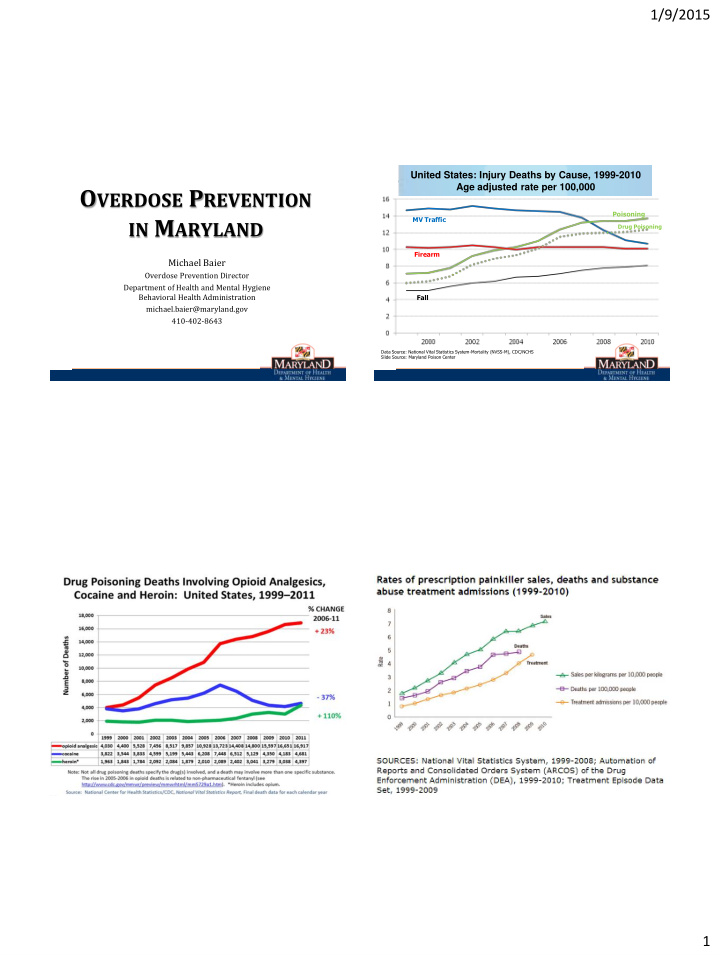



1/9/2015 United States: Injury Deaths by Cause, 1999-2010 O VERDOSE P REVENTION Age adjusted rate per 100,000 Poisoning IN M ARYLAND MV Traffic Drug Poisoning Firearm Michael Baier Overdose Prevention Director Department of Health and Mental Hygiene Behavioral Health Administration Fall michael.baier@maryland.gov 410-402-8643 Data Source: National Vital Statistics System-Mortality (NVSS-M), CDC/NCHS Slide Source: Maryland Poison Center 1
1/9/2015 2
1/9/2015 Number of Fentanyl-Related Deaths Occurring in Maryland by Month, May 2013-July 2014* *2014 counts are preliminary and include deaths reported by OCME through August 2014. 10 3
1/9/2015 • Overdose Prevention Council, • Data Initiatives, • Opioid Overdose Prevention Plans, and • Public Health Interventions. 4
1/9/2015 Overdose Prevention Council • Executive Order establishing the Council signed and • Maryland has enhanced surveillance of overdoses in the released Friday, June 27 th . State through several activities: • The Council will advise and assist in establishing a – Developed a statewide protocol for identifying overdose deaths, which is captured by the state’s Medical Examiner; coordinated, statewide effort to reduce the number of fatal and non-fatal overdose. – Created a database on overdose deaths, housed within the Health Department’s Virtual Data Unit; • Participants include: – Released annual reports and quarterly updates to examine fatal – GOCCP – DHMH overdose trends in the state; – Office of Problem – MSP – Signed MOUs to match overdose death data Solving Courts – DPSCS – MSDE – DJS – DHR – MIEMSS 5
1/9/2015 Naloxone Who Can Request PDMP Data? Opioid antagonist medication • Prescribers (in connection with medical care of patient) long used in emergency medicine to quickly and safely reverse • Dispensers (in connection with dispensing request) opioid overdose and restore breathing • Law Enforcement (existing investigation & subpoena) • Not a controlled substance • Licensing Boards (existing investigation & subpoena) • No “abuse potential” • Patient (may include parent/guardian for minors) • Low risk of adverse reaction • DHMH Agencies (existing investigation required) • Typically administered via IM • Other states’ PDMPs (if authorized and employing injection or intra-nasally with confidentiality, security and access standards at least as atomizer stringent as MD’s PDMP) • Rx drug under federal regulation • Researchers (de-identified data only) Expanding Naloxone Access • MIEMSS: trained 17,000+ Basic Life Support EMS • Maryland launched a public awareness campaign on providers to administer intranasal naloxone & supplied overdose prevention in summer 2014. ~800 ambulances statewide • MD Overdose Response Program (began March 2014) – Allows “3 rd parties” (lay people) to be trained on overdose recognition/response with naloxone – All LHDs and other community orgs authorized to do trainings – As of 9/30/14: 3,291 individuals trained, including 1,545 law enforcement officers; 43 naloxone administrations reported • Making naloxone standard of care in clinical practice – Secretary’s request to OTPs and somatic providers to begin prescribing naloxone 6
1/9/2015 • LOFRTs are comprised of multi-agency/multi-disciplinary members that conduct confidential case reviews of overdose deaths. – Teams identify missed opportunities for prevention, gaps in the system, and areas for increased collaboration. • Started as pilot in 3 jurisdictions; expanding to at least 17 • Passage of HB 1282 in 2014 establishes LOFRTs under Maryland law and allows any jurisdiction to establish a team. 7
Recommend
More recommend